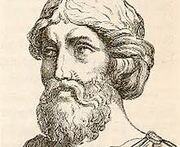
Although the Father of Geometry used primed numbers as part of a proof and became famous partly because of this, the first mentioning of prime numbers was by Pythagoras, author of the famous Pythagorean Theorem.
In October 2013, a new prime number was found. It is 257,885,161 − 1, also approximately written as 5.818872662322464421751002121132323686363708 × 1017425169 in scientific notation, having a whooping 17,425,170 digits! This beats the old 2008 record of 243112609-1! It was discovered at the GIMPS (the Great Internet Mersenne Prime Search). The mathematician Euclid of Alexandria "the Father of Geometry," proved that there is no largest prime number, since there are infinitely large amounts numbers. Although all mathematicians and geniuses know this, they continue to discover the next one because it is a great hobby. However, these people could not have done it without the help of some of the most important theorems - two of which is the Prime Numbers Theorem and the Fundamental Theorem of Arithmetic.
The Prime Numbers Theorem
For full article, see Prime Number Theorem:

The graph y=ln(x)
The Prime Numbers Theorem states the way how prime numbers and composite numbers can be differentiated. If a number k is randomly chosen from a range of 0 and the limit of n as n approaches infinity, the probabilty that it is prime is 1/ln(k), where ln(k) is the defined natural log of n. To simplify, the distance between one prime number to another is ln(K).
Mathematical Proof
1. Let's take the reciprical of all the prime numbers.
That would be 1/2 + 1/3 + 1/5 + 1/7 + ....1/p, where p is the largest prime number.
2. The divergent series approaches infinity, since there is no limit to this sum.
3. This shows that there is an infinite number of prime numbers since this sum would only grow until the sum is reached.
Corollary 1
π(x) is approximately equal to x/(log x-1)

The graph of y=log(x). Note how this is similar to the previous graph.
Corollary 2
The kth prime number is about equal to klog(k). However, keep in mind that this is still an approximation; there is no real way of determining the exact number.
Corollary 3
The chance of a random integer k being prime is approximately 1/log(k). This is true since that log base e of k is equal to ln(e). Note that their graphs are similar, as shown with the graphs of y=ln (x) and y=log(x) as shown in the above adn right pictures..
The Fundamental Theorem of Arithmetic
The Fundamental Theorem of Arithmetic, or the unique prime factorization theorem, states that an integer k such that 0<k<∞ is prime itself or composed of other prime numbers (hence the name composite numbers). Prime factorization is the same for each integer.
For example: the prime factorization of 1000 is 23 x 53. The factor of primes is always unique, no matter how it is done. No matter how 1000 is broken up, when expressed as a prime factorization, will be 23 x 53.
Proof
There are many proofs for this theorem, but three are using the existence theorem, uniqueness theorem, and the proof of the uniqueness theorem.
The Top Ten Largest Known Prime Numbers
As of 2013, here are the top ten largest known prime numbers!
|
Rank |
Prime number |
Found by |
Found date |
Number of digits |
|
1st |
257,885,161 − 1 |
GIMPS |
2013 January 25 |
17,425,170 |
|
2nd |
243,112,609 − 1 |
GIMPS |
2008 August 23 |
12,978,189 |
|
3rd |
242,643,801 − 1 |
GIMPS |
2009 April 12 |
12,837,064 |
|
4th |
237,156,667 − 1 |
GIMPS |
2008 September 6 |
11,185,272 |
|
5th |
232,582,657 − 1 |
GIMPS |
2006 September 4 |
9,808,358 |
|
6th |
230,402,457 − 1 |
GIMPS |
2005 December 15 |
9,152,052 |
|
7th |
225,964,951 − 1 |
GIMPS |
2005 February 18 |
7,816,230 |
|
8th |
224,036,583 − 1 |
GIMPS |
2004 May 15 |
7,235,733 |
|
9th |
220,996,011 − 1 |
GIMPS |
2003 November 17 |
6,320,430 |
|
10th |
213,466,917 − 1 |
GIMPS |
2001 November 14 |
4,053,946 |
Trivia
- Although this might not seem important, the EFF (the Electroninc Frontier Foundation) gives out prizes for new prime numbers discovered in the world. In 1999, this foundation granted a $50,000 prize. This theorem, indirectly. may help mathematicians and other geniuses to find new ones. Although it is not accurate, it gives a ballpark of numbers rather than shooting at the dark.
- All largest known prime numbers can be able to be expressed in the form 2n-1.
- If the number of digits in the prime number exceeds another certain amount of digits, the foundation will give out another prize.
